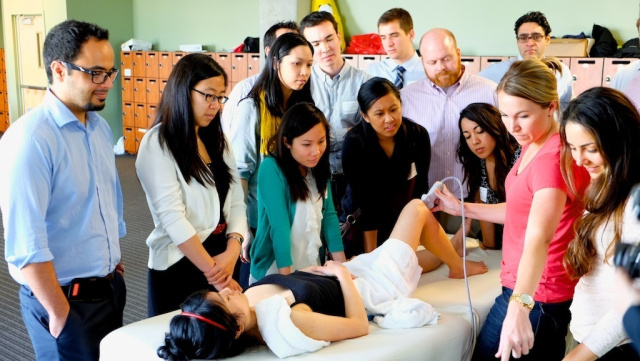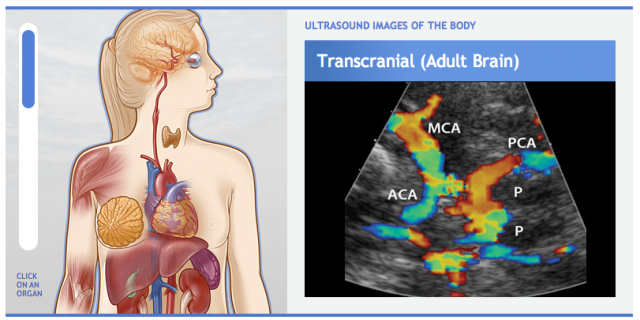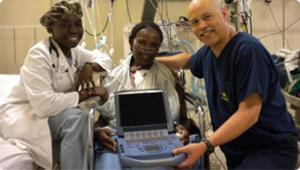Dr. Liz Turner discusses Visual Medicine on Sonosite's GLIMPSE show
Lorem ipsum dolor sit amet, consectetur adipiscing elit. Vivamus fringilla mollis varius. Proin est tellus, congue eu sagittis id, suscipit eget mi. Phasellus non ligula vel erat facilisis adipiscing at et ligula. Maecenas eu nisl at magna egestas vestibulum. Fusce ligula leo, hendrerit convallis nibh ac, lobortis vulputate diam. Nullam gravida ac leo nec interdum. Vivamus quis neque quis ligula ultrices euismod. Nulla interdum, lacus luctus rhoncus euismod, velit augue tristique mi, vehicula tristique sem dolor nec lectus. Pellentesque non convallis ipsum. …
Dr. Byron Patterson, Discusses Visual Medicine on Sonosites GLIMPSE Show
Lorem ipsum dolor sit amet, consectetur adipiscing elit. Vivamus fringilla mollis varius. Proin est tellus, congue eu sagittis id, suscipit eget mi. Phasellus non ligula vel erat facilisis adipiscing at et ligula. Maecenas eu nisl at magna egestas vestibulum. Fusce ligula leo, hendrerit convallis nibh ac, lobortis vulputate diam. Nullam gravida ac leo nec interdum. Vivamus quis neque quis ligula ultrices euismod. …
Dr. Francis Yamazaki, Discusses Anesthesia on Sonosite's GLIMPSE Show
Lorem ipsum dolor sit amet, consectetur adipiscing elit. Vivamus fringilla mollis varius. Proin est tellus, congue eu sagittis id, suscipit eget mi. Phasellus non ligula vel erat facilisis adipiscing at et ligula. Maecenas eu nisl at magna egestas vestibulum. Fusce ligula leo, hendrerit convallis nibh ac, lobortis vulputate diam. Nullam gravida ac leo nec interdum. Vivamus quis neque quis ligula ultrices euismod. …
Dr. John Christian Fox and Joel Shlang discuss Medical Education, Sonosite's GLIMPSE Show
Lorem ipsum dolor sit amet, consectetur adipiscing elit. Vivamus fringilla mollis varius. Proin est tellus, congue eu sagittis id, suscipit eget mi. Phasellus non ligula vel erat facilisis adipiscing at et ligula. Maecenas eu nisl at magna egestas vestibulum. Fusce ligula leo, hendrerit convallis nibh ac, lobortis vulputate diam. Nullam gravida ac leo nec interdum. Vivamus quis neque quis ligula ultrices euismod. Nulla interdum, lacus luctus rhoncus euismod, velit augue tristique mi, vehicula tristique sem dolor nec lectus. Pellentesque non convallis ipsum. …
Ultrafest UCI 2014 Highlight Film

Ultrafest Ultrasound Festival hosted at UCI (University of California, Irvine) 2014 …
Visit AIUM's Ultrasound in Medical Education Interest Group

The site features an ultrasound interactive graphic. AIUM’s Ultrasound in Medical Education Interest Group collaborative portal is intended to be a clearinghouse of resources related to facilitating the integration of ultrasound into medical school education. …
Interview about XYZ with Dr. Christian Fox, University of California, Irvine
Interview about XYZ with Dr. Christian Fox, University of California, Irvine
Interview Summary
Why this is important?
Pull Quotes and Video Time Codes
Internal links to any Sonosite related content
Dr. Christian Fox is a Professor of Clinical Emergency Medicine, Step 3, Emergency Medicine
School of Medicine. …
Ultrasound of the Shoulder, Part 1
The American Journal of Orthopedics
Alan M. Hirahara, MD, FRCS(C), and Alberto J. …
Game-Changer
Imaging Economics | September 2011
"Use of ultrasound at the point of care is growing in sports medicine. In office practice and on the playing field, this versatile technology is now widely used by team physicians in professional sports to provide dynamic real-time evaluation and safe, accurate treatment of players' injuries. Most European soccer clubs, as well as the National Basketball Association, are taking advantage of ultrasound's well-established benefits for improving patient safety and outcomes, at a fraction of the cost of MRI or CT scans." Read the full article by Steven Sampson, DO, on the Imaging Economics site. …
Joint Commission and the Risk of Medical Imaging Radiation
The Joint Commission is sending a powerful notice about the radiation risks of diagnostic imaging. Its August 24, 2011, Sentinel Event Alert clearly states that diagnostic radiation can save lives. That is not in dispute. What is at issue is the amount of radiation patients receive over time and the risk for long-term damage.
Over the last 20 years, Americans’ exposure to ionizing radiation has nearly doubled. As the Joint Commission states, “…any physician can order tests involving exposure to radiation at any frequency, with no knowledge of when the last of when the patient was irradiated or how much radiation the patient received.” The World Health Organization’s International Agency for Research on Cancer, the Agency for Toxic Substances and Disease Registry of the Centers for Disease Control and Prevention and the National institute of Environmental Health Sciences all classify x-rays as a carcinogen.
As an Emergency Physician, I recognize the value of x-rays and CT scans and use them when they are medically appropriate. In its Sentinel Event Alert, one of the Joint Commission’s recommended actions is use other imaging modalities when appropriate: “In order to reduce the expose of the patient to ionizing radiation, use other imaging techniques, such as ultrasound or MRI, whenever these tests will produce the required diagnostic information at a similar quality level.” …
Good News about Healthcare Reform

The Good News About Healthcare Reform: Smarter Use of Imaging Technology Helps Reduce Hospital Errors, Healthcare Costs
Paul Sierzenski, MD …
$330 Million Risk: What Boards Should Know

In his article that advises American Hospital Association member trustees, Rodney Hockman, MD warns that hundreds of hospitals are likely to be penalized by Medicare for patient injuries under the Hospital-Acquired Condition (HAC) Reduction Program starting in October 2014. He points out that each penalized hospital stands to lose nearly $434,000 in Medicare reimbursements on average, with large hospital systems and those with a high volume of Medicare payments potentially facing much greater losses should they provide unsafe care.
Dr. Hochman points to institutions using a bundle of best practices to address this, including 353-bed White Memorial Hospital, part of the Adventist Health System in Los Angeles, to eliminate two of the serious complications used to determine penalties under Medicare’s HAC Reduction Program: pneumothorax and central line-associated bloodstream infections (CLABSIs). Both conditions are now included on AHRQ’s list of patient safety indicators. …
Smarter Use of Imaging Technology: Reduce Errors Costs
Medical errors continue to be a major problem in the US healthcare system, with hospital acquired infections (HAC) becoming an area of greater focus and where significant financial penalties are being incurred. Medicare has added one especially dangerous--or even potentially fatal--adverse event, iatrogenic pneumothorax during central line placement, to its HAC list. Along with putting patients in peril, the mistake can also increase hospital costs by up to $45,000 per incident, according to a study by the Agency for Healthcare Quality and Research (AHRQ).
Many excellent studies show that ultrasound guidance can powerfully improve the safety and success of this very common procedure. In fact, in one randomized study of 900 critical care patients, use of ultrasound visualization reduced the rate of collapsed lung during central line placement to zero, compared to 2.4 percent for blind placement.
Dr. Sierzenski is the Director of Emergency, Trauma and Critical Care Ultrasound for Christiana Care Health System’s Department of Emergency Medicine. He is also the Chair, Government Policy & Public Relations for the American College of Emergency Physicians Ultrasound Section and a Master's Candidate in Health Quality and Safety at the Jefferson School of Population Health.
…
$330 Million Risk: What Boards Should Know

In his article that advises American Hospital Association member trustees, Rodney Hockman, MD warns that hundreds of hospitals are likely to be penalized by Medicare for patient injuries under the Hospital-Acquired Condition (HAC) Reduction Program starting in October 2014. He points out that each penalized hospital stands to lose nearly $434,000 in Medicare reimbursements on average, with large hospital systems and those with a high volume of Medicare payments potentially facing much greater losses should they provide unsafe care.
Dr. Hochman points to institutions using a bundle of best practices to address this, including 353-bed White Memorial Hospital, part of the Adventist Health System in Los Angeles, to eliminate two of the serious complications used to determine penalties under Medicare’s HAC Reduction Program: pneumothorax and central line-associated bloodstream infections (CLABSIs). Both conditions are now included on AHRQ’s list of patient safety indicators. …
Smarter Use of Imaging Technology: Reduce Errors Costs
Medical errors continue to be a major problem in the US healthcare system, with hospital acquired infections (HAC) becoming an area of greater focus and where significant financial penalties are being incurred. Medicare has added one especially dangerous--or even potentially fatal--adverse event, iatrogenic pneumothorax during central line placement, to its HAC list. Along with putting patients in peril, the mistake can also increase hospital costs by up to $45,000 per incident, according to a study by the Agency for Healthcare Quality and Research (AHRQ).
Many excellent studies show that ultrasound guidance can powerfully improve the safety and success of this very common procedure. In fact, in one randomized study of 900 critical care patients, use of ultrasound visualization reduced the rate of collapsed lung during central line placement to zero, compared to 2.4 percent for blind placement.
Dr. Sierzenski is the Director of Emergency, Trauma and Critical Care Ultrasound for Christiana Care Health System’s Department of Emergency Medicine. He is also the Chair, Government Policy & Public Relations for the American College of Emergency Physicians Ultrasound Section and a Master's Candidate in Health Quality and Safety at the Jefferson School of Population Health.
…
Final 2016 Medicare Inpatient Rule Contains Provisions to Promote Patient Safety
2015-09-28T07:00:00Final 2016 Medicare Inpatient Rule Contains Provisions to Promote Patient SafetyJill Rathbun
Jill Rathbun of Galileo Consulting, in her continuing contribution to Dot.Med, explains key points for the FY 2016 CMS Inpatient Prospective Payment Final Rule. Ultrasound plays a role in the Hospital Acquired Condition Program and may contribute to lowering complications.Read article …
Ultrasound-Guided Procedures: Financial and Safety Benefits
ICU ManagementDiku Mandavia, MD, FACEP, FRCPC, Chief Medical Officer at Sonosite, and clinical associate professor of emergency medicine at the University of Southern CaliforniaDr. Mandavia discusses how ultrasound guidance adds value to both patient safety and removing costs from healthcare delivery.Read article …
An Active September in the Nation's Capital
DOT.MedJill RathbunContinuing in a series of Federal policy updates, Jill Rathbun of Galileo Consulting provides the latest news on imaging policy and payments.
Read article …
AIUM Recognizes ACEP's Emergency Ultrasound Guidelines
While not all portable ultrasound examinations are of an emergency nature, its predominant use originated within the “we-need-it-STAT” category. Hence, the significant role of emergency medicine in contributing to point-of-care ultrasound best practices and insight into the valuable role ultrasonography can play at the bedside.
In mid-November, the contributions of emergency physicians to the proper use of “focused emergency ultrasound examinations” (a.k.a. point-of-care ultrasound) was acknowledged by the American Institute of Ultrasound in Medicine (AIUM). According to their November 17, 2011,
press release, the AIUM now recognizes the American College of Emergency Physician’s (ACEP) Policy Statement
Emergency Ultrasound Guidelines as “meeting the qualifications for performing ultrasound in the emergency settings. These guidelines describe the education and training required by emergency physicians to achieve competency for the performance of focused emergency ultrasound applications in clinical practice.”
…
A Big Thank-You From Tenwek, Kenya

This story reminds us yet again how lives can be saved when dedicated teamwork combines with progressive medical technology.
…
